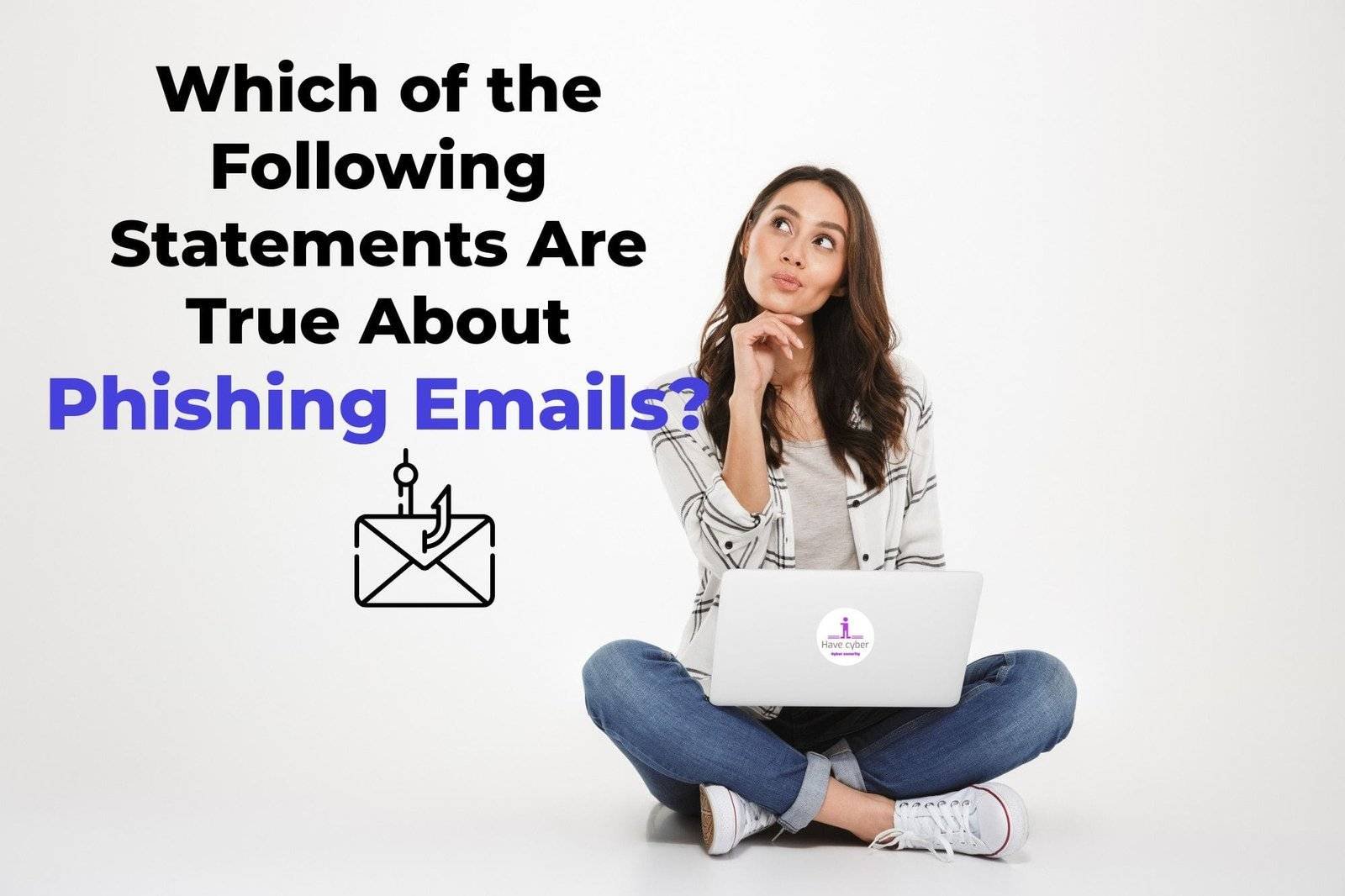Which of the Following Statements Are True About Phishing Emails?
Phishing emails are clever traps intended to trick and take advantage of innocent users; they are more than just unpleasant spam that clogs your inbox. To protect your digital assets and personal information in the modern digital world, where cyber attacks are a serious concern, you must understand the true nature of phishing emails. This post will explain the mysteries surrounding phishing emails, point out warning indicators, and determine whether claims about them are accurate. Get ready for an interesting trip into the cunning realm of cybercrime.
What is a Phishing Email?
Phishing emails are a common type of cybercrime that uses social engineering techniques to trick users into revealing personal information or taking dangerous activities. These misleading messages frequently pose as reputable organizations, including banks, social media sites, or government offices, to give the impression that they are authentic.
Definition and Characteristics
essentially phishing emails are skillfully designed to resemble real communication channels, using a variety of strategies to trick receivers. Typically, they display several important characteristics:
- Spoofed Sender Information: Phishing emails usually use spoofing to make it look like they come from reliable sources. On closer inspection, recipients could spot anomalies or discrepancies in the sender’s information, including misspelled domain names or strange email addresses.
- Urgent Language and Threats: Phishing emails frequently use startling language or threats to induce a sense of urgency or panic in their recipients. The goal is to have them act immediately. These strategies are meant to bypass reason and force victims to agree with the attackers’ demands.
- Suspicious Links and Attachments: phishing emails frequently contain malicious links or attachments that aim to direct users to phony websites or download dangerous malware. These URLs, even though they seem genuine, could lead users to phishing pages that collect personal data or start malware downloads.
Phishing emails present a danger to cybersecurity because they are essentially a smart combination of technological deception and psychological manipulation. Individuals and businesses must comprehend the strategies these sneaky scammers use to reduce the possibility of becoming a victim.
Common Features of Phishing Emails

Phishing emails use a range of strategies to trick their target and convince them to do things that will help their attackers. By becoming acquainted with these typical characteristics, we may better position ourselves to recognize and steer clear of phishing scams.
Spoofed Sender Information
Spoofing the sender’s address to make the message seem like it came from a reliable source is one of the main strategies used by phishing emails. This frequently involves altering the sender’s display name or email address to look like a reliable organization, bank, or government body. Recipients might, however, pick up on minute anomalies or discrepancies in the sender’s information, including misspelled domain names or strange email addresses, upon closer inspection. People can recognize these warning signs and prevent themselves from being victims of phishing scams by being alert and closely analyzing sender information.
Urgent Language and Threats
Phishing emails commonly use dire rhetoric or threats to create fear or panic in recipients, pressuring them to act immediately. These notifications might assert that immediate action is necessary to avoid account suspension, illegal access, or other serious repercussions. The attackers hope to trigger spontaneous responses by creating a sense of urgency that circumvents the recipients’ rational thought process. However, as legitimate organizations usually do not use threatening language or demand quick action via email, it is important to maintain composure and objectively assess the credibility of such letters.
Suspicious Links and Attachments
Using suspicious links or attachments in phishing emails is another way to identify the scam since it aims to trick recipients into divulging personal information or downloading harmful malware. These links could seem genuine at first, but they point to phishing or fake websites that are used to steal personal information such as bank account details or login credentials. Similar to this, attachments could include ransomware or malware intended to infect the recipient’s computer or network. To reduce the potential danger of these attacks, people should avoid opening attachments or clicking links from unknown or dubious sources. Instead, they should use other methods to confirm the sender’s authenticity.
True Statements About Phishing Emails
Phishing emails are well known for their ability to deceive and manipulate users into disclosing private information or inadvertently taking dangerous activities. This section will look at a few claims regarding phishing emails and assess their validity.
Statement 1: Phishing Emails Can Mimic Legitimate Companies
True. The capacity of phishing emails to imitate the branding and communication methods of reputable businesses is one of their unique characteristics. Attackers frequently devote a significant amount of time and energy to creating believable emails that closely resemble correspondence from reliable sources, such as banks, social media sites, or e-commerce sites. Phishing emails try to make receivers less cautious and boost their chances of success by using recognizable logos, formatting, and language.
Statement 2: Phishing Emails Often Contain Grammatical Errors
True. While some phishing emails are meticulously created to look real, many of them have obvious spelling, grammar, or sentence construction mistakes. These mistakes could be the result of the hurry with which phishing attacks are carried out or the language barrier that foreign criminals must overcome. As a result, recipients need to be on the lookout for any linguistic irregularities that could point to a fake email and stay cautious.
Statement 3: Phishing Emails May Request Personal Information
True. Phishing emails frequently include techniques to coerce recipients into giving sensitive information, like financial information, login passwords, or personal identification numbers (PINs). These might be requests to claim awards or rewards, update account information, or validate login credentials, among other things. However reliable businesses usually don’t ask for this kind of information over email, especially when it comes to uninvited or unexpected correspondence. As a result, recipients should use caution and avoid responding to email requests with personal information.
Statement 4: Phishing Emails Can Install Malware
True. Phishing emails are frequently used as distribution channels for malware, such as viruses, ransomware, or spyware, which is intended to infect the recipient’s device or network. Phishing emails may contain malicious links or attachments that could inadvertently install malware on the recipient’s computer, giving attackers access to the victim’s system and enabling them to steal confidential information or perform other malicious tasks. People should avoid downloading attachments or clicking on links from unidentified or untrustworthy sources to reduce their chance of contracting malware. They should also keep their antivirus software and security measures up to date.
Conclusion
In today’s digital world, phishing emails have become an ever-present threat that takes advantage of technological weaknesses and human weaknesses to commit cybercrimes. Phishing emails impersonate trusted businesses, use deceptive strategies, and make use of social engineering techniques in an attempt to deceive receivers and compromise their digital assets and personal information. Nonetheless, people and companies can reduce the risk presented by these sneaky frauds by being watchful, carefully analyzing email content, and implementing proactive cybersecurity measures.
In conclusion, combating phishing attempts requires a strong emphasis on awareness and education. Users can protect themselves from being victims of these nefarious schemes by being aware of the typical characteristics of phishing emails, identifying assertions that are accurate about them, and using best practices for email security. In the digital age, let’s continue to be alert, educated, and united in our efforts to counter the ever-present threat posed by phishing emails.
FAQs
How can I recognize a phishing email?
Phishing emails often exhibit suspicious characteristics, such as spoofed sender information, urgent language, and requests for personal information. Be cautious of unexpected or unsolicited messages and scrutinize sender details and content for inconsistencies.
What should I do if I receive a suspected phishing email?
If you receive a suspicious email, refrain from clicking on any links or downloading attachments. Instead, report the email to your organization’s IT department or the appropriate authorities and delete it from your inbox.
Can phishing emails target specific individuals or organizations?
Yes, cybercriminals often tailor phishing emails to target specific individuals or organizations, a technique known as spear-phishing. These targeted attacks may involve researching the intended victims to craft personalized and convincing messages.
How can I enhance my cybersecurity against phishing attacks?
Stay informed about common phishing tactics and regularly update your cybersecurity awareness. Implement security measures such as multi-factor authentication, email filtering, and employee training to mitigate the risk of falling victim to phishing scams.
What are some warning signs of a phishing email?
Look out for red flags such as misspelled words, generic greetings, unsolicited requests for personal information, and suspicious attachments or links. Trust your instincts and err on the side of caution when encountering suspicious emails.







